How to Meditate for Boosting Your Mindfulness Practice dives into the world of meditation and mindfulness, offering valuable insights and techniques to enhance your mental well-being. Let’s explore the transformative power of meditation in cultivating mindfulness.
As we journey through different meditation techniques, setting up a serene meditation space, mastering breathing exercises, and engaging in mindful body scan meditations, you’ll discover practical ways to elevate your mindfulness practice to new heights.
Introduction to Meditation for Boosting Mindfulness
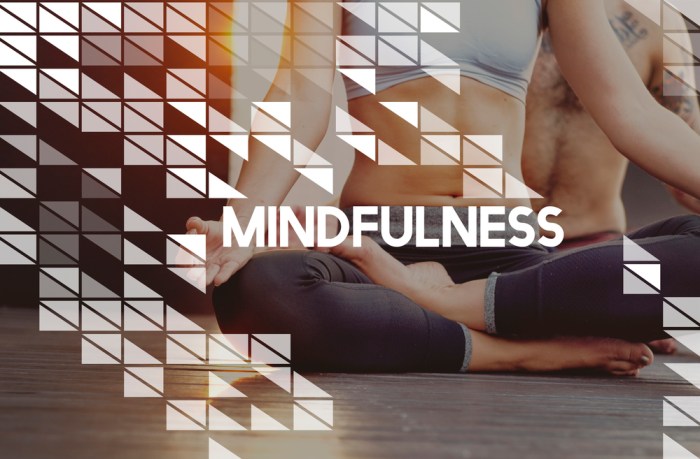
Mindfulness is the practice of being fully present and engaged in the current moment, without judgment. It involves paying attention to thoughts, feelings, bodily sensations, and the surrounding environment. Incorporating mindfulness into daily life can reduce stress, improve focus, and enhance overall well-being.
Meditation is a powerful tool that can enhance mindfulness practices. By engaging in meditation regularly, individuals can cultivate awareness, decrease reactivity to stressors, and develop a greater sense of inner peace. Meditation helps to train the mind to focus on the present moment and observe thoughts without getting caught up in them.
Stressed out and need a pick-me-up? Well, my friend, How to Meditate for Transforming Stress into Positivity is the answer to all your woes. It’s like a breath of fresh air in a world full of chaos, helping you find your zen amidst the madness.
Benefits of Incorporating Meditation into a Mindfulness Routine
- Improved Concentration: Meditation helps to sharpen focus and attention, allowing individuals to be more present in daily activities.
- Stress Reduction: Regular meditation practice has been shown to lower cortisol levels and reduce overall stress levels.
- Emotional Regulation: Meditation can enhance emotional intelligence by helping individuals observe their emotions without reacting impulsively.
- Enhanced Self-Awareness: Through meditation, individuals can develop a deeper understanding of themselves and their thought patterns.
- Greater Resilience: By fostering a sense of inner calm and peace, meditation can help individuals navigate challenges with more resilience.
Types of Meditation Techniques
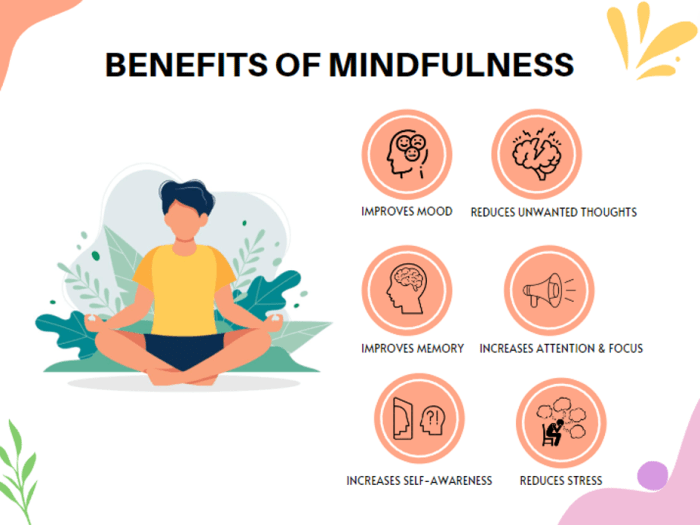
When it comes to boosting mindfulness through meditation, there are various techniques that can be practiced. Each technique offers unique benefits and can cater to different preferences and needs.
Focused Attention Meditation
Focused attention meditation involves concentrating on a single point of focus, such as your breath, a specific object, or a mantra. The goal is to train your mind to stay present and focused on the chosen point, helping to cultivate mindfulness and awareness of the present moment. By repeatedly bringing your attention back to the focal point whenever your mind wanders, you can improve your ability to concentrate and reduce distractions.
So, you’re feeling down and out, huh? Well, fret not my friend! Let me tell you about 7 Ways Meditation Can Help You Cope with Grief. It’s like a soothing balm for your soul, helping you navigate through the storm of emotions with grace and ease.
Open Monitoring Meditation, How to Meditate for Boosting Your Mindfulness Practice
Open monitoring meditation, on the other hand, involves observing and being aware of all aspects of your experience without judgment. This technique encourages you to notice any sensations, thoughts, or emotions that arise in the present moment, without getting attached to them or trying to change them. By developing a non-reactive awareness, you can enhance your mindfulness and acceptance of whatever arises in your mind and body.
Now, if you’re looking to heal and recover from life’s punches, look no further than How to Meditate for Healing and Recovery. It’s like a magic potion that works wonders on your body, mind, and spirit. Trust me, you’ll feel like a whole new person!
Setting Up a Meditation Space: How To Meditate For Boosting Your Mindfulness Practice
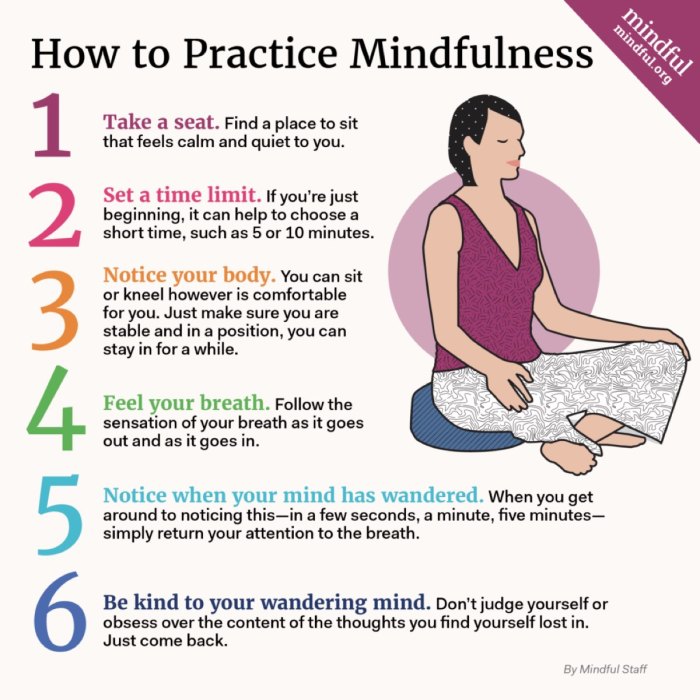
Creating a peaceful and conducive meditation space at home is essential for a successful mindfulness practice. Here are some tips to help you set up the perfect meditation space:
Comfortable Seating Arrangement
- Choose a comfortable cushion or chair that supports an upright posture.
- Ensure that your spine is straight to allow for easy breathing and focus.
- Consider using a meditation cushion or yoga mat for added comfort during longer meditation sessions.
Incorporating Calming Elements
- Light candles or burn incense to create a relaxing atmosphere.
- Use essential oils like lavender or sandalwood to promote a sense of calm and relaxation.
- Add plants or natural elements to bring a touch of nature into your meditation space.
Breathing Exercises for Mindfulness
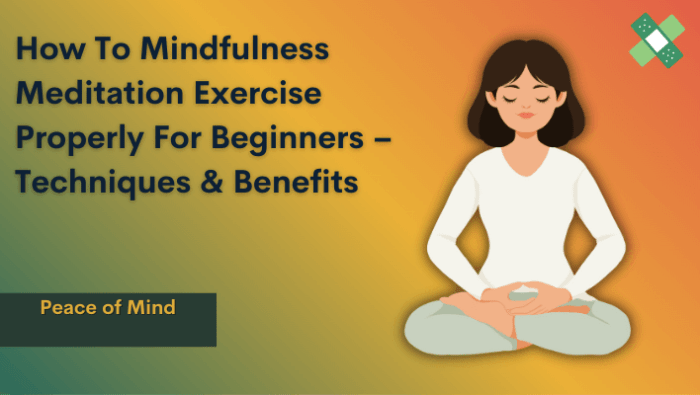
Breathing plays a crucial role in enhancing mindfulness during meditation. It serves as an anchor to bring your focus back to the present moment, allowing you to cultivate a sense of awareness and relaxation.
Deep Breathing Exercise
One simple breathing exercise involves taking deep breaths in and out. Find a comfortable seated position, close your eyes, and take a deep breath in through your nose, allowing your belly to rise. Hold the breath for a few seconds, and then exhale slowly through your mouth. Repeat this process for several minutes, focusing on the sensation of your breath entering and leaving your body.
Counting Breath Exercise
Another effective technique is the counting breath exercise. Inhale deeply through your nose while counting to four, hold your breath for a count of four, and then exhale slowly to a count of four. Repeat this cycle several times, concentrating on the rhythm of your breath and the numbers you are counting.
Box Breathing Technique
The box breathing technique involves inhaling for a count of four, holding your breath for a count of four, exhaling for a count of four, and then holding your breath again for a count of four. This pattern creates a square or “box” shape with your breath, helping to regulate your breathing and calm your mind.
Benefits of Focusing on Breath
- Improves concentration and focus
- Reduces stress and anxiety
- Promotes relaxation and a sense of calm
- Enhances mindfulness and awareness of the present moment
Mindful Body Scan Meditation
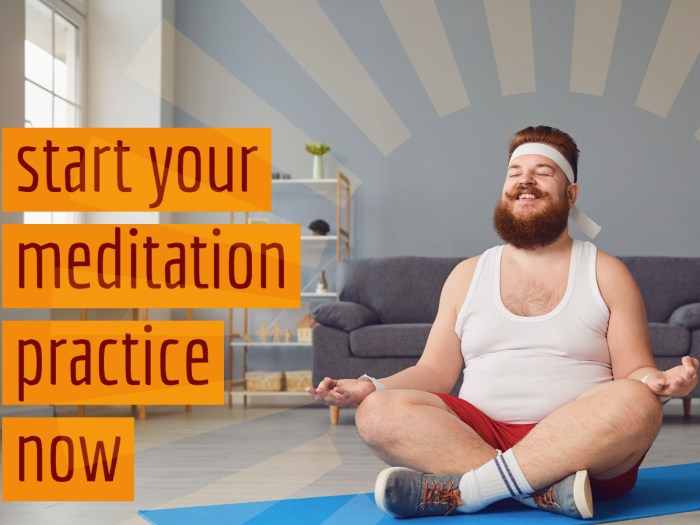
Body scan meditation is a mindfulness practice that involves focusing on different parts of the body, progressively moving from one area to another. This technique helps increase self-awareness, reduce stress, and promote relaxation.
Step-by-Step Guide for Mindful Body Scan Meditation
To perform a mindful body scan during meditation, follow these steps:
- Find a comfortable position, either sitting or lying down, and close your eyes.
- Start by bringing your attention to your breath, taking a few deep breaths to center yourself.
- Shift your focus to your toes, noticing any sensations or tension in that area. Take a deep breath in and release any tension as you exhale.
- Gradually move your attention up through each part of your body, from your feet to your head, acknowledging any sensations without judgment.
- Stay with each body part for a few breaths, allowing yourself to fully experience the present moment.
- Once you have scanned your entire body, take a few moments to bask in the overall sense of relaxation and awareness.
- Slowly bring your awareness back to your breath before gently opening your eyes.
Benefits of Body Scan Meditation
Body scan meditation can help cultivate a deep awareness of the body and mind by:
- Increasing self-awareness and mindfulness of bodily sensations.
- Reducing stress and promoting relaxation by releasing tension in different body parts.
- Improving emotional regulation and mental clarity through focused attention.
- Enhancing overall well-being and promoting a sense of calmness and presence.
Embark on your mindfulness journey armed with the knowledge and tools provided in this guide. By incorporating these practices into your daily routine, you can experience increased awareness, reduced stress, and a profound sense of inner peace. Take the first step towards a more mindful existence today.